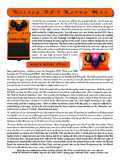Transcription of The streak camera is an ultra high-speed detector …
1 The streak camera is an ultra high -speed detectorwhich captures light emission phenomena occurringin extremely shorttime booklet has been put together in order to introduce the operating principle of streak cameras, show some examples of how streak cameras are used, offer guidelines on how to select a streak camera , and explain the terms used in connection with these instruments. We hope those who are interested in streak cameras and those who are considering buying a streak camera would find it useful. If you are looking for information on a specific product model, HAMAMATSU has individual catalogs available which describe the various models in greater detail. Please refer to those catalogs for the model in which you are is a streak camera ? (What is a streak camera ? / Operating Principle / Features)System ConfigurationDefinition of TermsApplications (Semiconductor Physics/Photochemistry / Optical Communications / Fabrication of high quality thin films / Laser-induced Discharge / high -energy / Laser Nuclear Fusion)Reference Documents Pertaining to streak CamerasPage345810 Table of Tube3 Fig.
2 1 shows the operating principle of the streak camera . The light being measured passes through a slit and is formed by the optics into a slit image on the photocathode of the streak tube. At this point, four optical pulses which vary slightly in terms of both time and space, and which have different optical intensities, are input through the slit and arrive at the incident light on the photocathode is converted into a number of electrons proportional to the intensity of the light, so that these four optical pulses are converted sequentially into electrons. They then pass through a pair of accelerating electrodes, where they are accelerated and bombarded against a phosphor the electrons produced from the four optical pulses pass between a pair of sweep electrodes, high voltage is applied to the sweep electrodes at a timing synchronized to the incident light (see Fig.)
3 2). This initiates a high -speed sweep (the electrons are swept from top to bottom). During the high -speed sweep, the electrons, which arrive at slightly different times, are deflected in slightly different angles in the vertical direction, and enter the MCP (micro-channel plate).As the electrons pass the MCP, they are multiplied several thousands of times, after which they impact against the phosphor screen, where they are converted again into the phosphor screen, the phosphor image corresponding to the optical pulse which was the earliest to arrive is placed in the uppermost position, with the other images being arranged in sequential order from top to bottom, in other words, the vertical direction on the phosphor screen serves as the time axis. Also, the brightness of the various phosphor images is proportional to the intensity of the respective incident optical pulses.
4 The position in the horizontal direction of the phosphor image corresponds to the horizontal location of the incident this way, the streak camera can be used to convert changes in the temporal and spatial light intensity of the light being measured into an image showing the brightness distribution on the phosphor screen. We can thus find the optical intensity from the phosphor image, and the time and incident light position from the location of the phosphor SIGNALSWEEP CIRCUITPHOTOCATHODEACCELERATINGMESHMCPPH OSPHORSCREENSTREAK IMAGE ONPHOSPHOR SCREENSWEEP ELECTRODETIMESPACEPHOSPHOR IMAGESPACEPHOSPHOR SCREENINCIDENT LIGHTSWEEP VOLTAGETRIGGER Operating Principle of the streak Operation Timing (at time of sweep)Although we call it a " camera ", a streak camera is quite different from the video cameras and still cameras that we load with film to take pictures of the people and objects around streak camera is a device to measure ultra -fast light phenomena and delivers intensity vs.
5 Time vs. position (or wavelength) information. It's name dates back to the early days of the high speed rotating drum cameras. These cameras would " streak " reflected light onto film. No other instruments which directly detect ultra -fast light phenomena have better temporal resolution than the streak the streak camera is a two dimensional device, it can be used to detect several tens of different light channels simultaneously. For example, used in combination with a spectroscope, time variation of the incident light intensity with respect to wavelength can be measured (time resolved spectroscopy). Used in combination with proper optics, it is possible to measure time variation of the incident light with respect to position (time and space-resolved measurement).Operating PrincipleWhat is a streak camera ?
6 4 Simultaneous measurement of light intensity on both the temporal and spatial axis (wavelength axis)By positioning a multi-channel spectroscope in front of the slit (for the incident light) of the streak camera , the spatial axis is reckoned for the wavelength axis. This enables changes in the light intensity on the various wavelengths to be measured (timeresolved spectroscopy). Superb temporal resolution of less than psThe streak camera boasts a superb maximum temporal resolution of ps. This value of ps corresponds to the time it takes for light to advance a mere mm. Handles anything from single event phenomena to high -repetition phenomena in the GHz rangeA wide range of phenomena can be measured simply by replacing the modular sweep unit. Measurement ranges from X-rays to the near infrared raysA streak tube ( detector ) can be selected to match any wavelength range from X-rays to near infrared rays.
7 ultra - high sensitivity (single photoelectron can be detected)The streak tube converts light into electrons, and then multiply it electrically. By this, it can measure faint light phenomena not to be seen by the human eyes. This enables monitoring of extremely faint light, even single photoelectron can be detected. Dedicated readout systemA dedicated readout system is available which allows images recorded by a streak camera ( streak images) to be displayed on video monitor and analyzed in real time. This enables the data to be analyzed immediately without the delay of film Basic System Configration of streak CameraFeaturesIn order to measure ultra - high speed optical phenomena using a streak camera , a trigger section and a readout section are required. The basic configuration of this system is shown trigger section controls the timing of the streak sweep.
8 This section has to be adjusted so that a streak sweep is initiated when the light being measured arrives at the streak camera . For this purpose, we use a delay unit, which controls how long the trigger signal which initiates the streak sweep is delayed, and a frequency divider, which divides the frequency of the external trigger signal if the repetition frequency of the trigger signal is too high . Also, in cases where the trigger signal cannot be produced from the devices such as a laser, it has to be produced from the light being measured itself, and this requires a PIN readout section reads and analyzes streak images produced on the phosphor screen, which is on the output side of the streak camera . Because the streak image is faint and disappears in an instant, a high -sensitivity camera is used.
9 Analysis of streak images is done by transferring the images through a frame grabber board to a addition to the units which make up this basic configuration, there are spectroscopes, optics, and other peripheral equipments which can be used depending on each applicationsSystem ConfigurationEXTERNAL TRIGGER SIGNALTRIGGER SECTIONREADOUT SECTIONPIN PHOTODIODE(FOR OPTICAL TRIGGER) streak CAMERAHIGH-SENSITIVECAMERAFRAME-GRABBERB OARDCOMPUTERDELAY UNITFREQUENCY DIVIDERLIGHT TO BEMEASURED5 Temporal ResolutionThis is the boundary of the resolution which distinguishes between two events which are consecutive in terms of time. In HAMAMATSU catalogs, the temporal resolution is defined as the FWHM (full width at half maximum) of the intensity of the streak image in relation to an incident light pulse whose temporal width (pulse width) can be infinitely close to but not equal to zero.
10 Trigger JitterWhen a phenomenon is being repeated in order to measure it ( streak images are being summed), the position of the streak image on the phosphor screen jumps slightly each time the phenomenon is repeated, because of fluctuation in the operation timing of the sweep circuit and other factors. This fluctuation is called trigger jitter, and is one element which limits the temporal resolution of the system. It can be a particular problem with high -speed sweeps. (With low speed sweeps, the trigger jitter is lower than the time resolution, and can be ignored.)The trigger jitter is determined by the difference between the FWHM of a single pulse and the FWHM when pulses are summed together. Single-SweepEssentially, this term comes from the fact that only one sweep is involved (a single shot).













